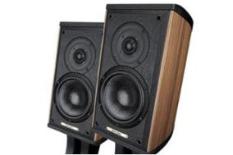What Hi-Fi? Verdict
The Liuto Monitors are as classy as standmounters come. With the right kind of music they can sound magical
Pros
- +
Seamless integration between the drivers
- +
fine stereo imaging with well-projected sound
- +
impressive build and finish
- +
dedicated stand works well
Cons
- -
Not the last word in dynamics or timing precision
Why you can trust What Hi-Fi?
There are few things classier looking in hi-fi than a Sonus Faber speaker. Irrespective of whether the brand's traditional leather and wood mix appeals, there's no denying the look is as luxurious as they come.
The positive news extends to the build, which is even more solid and polished than the price point suggests. These speakers could have cost another grand more and we still would have been impressed.
It may be hard to tell from the accompanying photo, but the Liuto Monitor is a relatively small unit. It stands just 35-cm high and features a combination of 15-cm mid/bass unit and 25mm soft dome tweeter.
As with most of the direct competition a reflex port is used to tune bass performance, in this case it's a rear-firing one. Ports are so common because they allow the speaker to produce more bass for a given cabinet size and improve sensitivity.
Certainly, the Liuto produces more bass than its small stature suggests.
So far none of the Liuto's basic engineering sounds particularly special, but as with most high-end products it's the details that matter.
Well-behaved cabinet
In getting these details right the company's engineers have produced a neat, mechanically well-behaved cabinet that gives the drive units a firm and well-damped foundation to work from.
Those drive units may not boast any flashy cone materials but work seamlessly together.
Unlike most speaker manufactures Sonus faber also go to the trouble of making a good dedicated speaker stand for its monitor.
The £499 stand isn't cheap, but consists of heavy top and bottom metal plates held together by wooden pillars, and it works brilliantly.
Normally, stands made by speaker manufacturers tend to be an afterthought, made for marketing rather than sonic reasons. Not here. The Liutos performed better on their dedicated stands than any alternative we tried, including Partington's similarly–priced and rather excellent Heavis.
Running-in time
These speakers take the best part of a week to run-in properly, and it's vital that any pair you listen to have been given that time otherwise they'll sound bright, thin and rather un-involving.
Once ready these are lovely speakers. They're fast and articulate, casting out a sound of impressive cohesion across the frequency band.
These speakers are at their considerable best when asked to produce acoustic instruments. They work a charm with an old mono recording of Miles Davis's Birth of the Cool where the speaker's agility, lightness of touch and impressive low-level dynamics come to the fore.
The same strengths are equally apparent with larger scale symphonies such as Tchaikovsky's No.6, but here they're coupled to an impressively expansive sound stage that pleases with both its scale and layering.
The Liutos are rather fussy about positioning and work best well away from all walls and (in our room at least) with a strong amount of angling towards the listening position.
Do this and you'll be greeted with a sonic image of great solidity and scope. The way these speaker project the sound is a major strength and it means that once properly set-up the Liutos simply ‘disappear' within their well crafted sound stage.
Move to electronic music and these standmounters are less confident. If the likes of Eminem or Tinchy Stryder are a large part of you musical diet the Sonus faber's slightly soft deep bass and lack of rhythmic precision will tone down your enjoyment a touch.
These speakers aren't bad in these respects, but they're behind the class leaders.
Lacking in neutrality
The Liutos aren't the most neutral speakers we've heard at this price level either – similarly priced ATCs and Spendors get closer to that ideal- but their presentation remains even enough to convince.
There's much to admire in these Italian monitors.
We can't see anyone disliking their build or enthusiastic approach to music replay. If you listen predominately to vocals or acoustic instruments these speakers would make a fine choice.
If not, there are better options for the money.
See all our hi-fi speaker Best Buys
What Hi-Fi?, founded in 1976, is the world's leading independent guide to buying and owning hi-fi and home entertainment products. Our comprehensive tests help you buy the very best for your money, with our advice sections giving you step-by-step information on how to get even more from your music and movies. Everything is tested by our dedicated team of in-house reviewers in our custom-built test rooms in London, Reading and Bath. Our coveted five-star rating and Awards are recognised all over the world as the ultimate seal of approval, so you can buy with absolute confidence.


